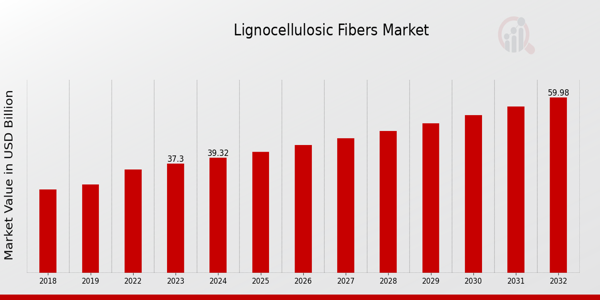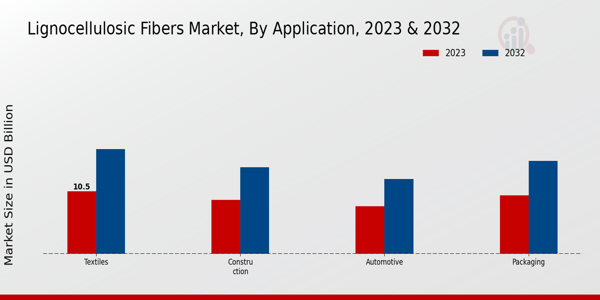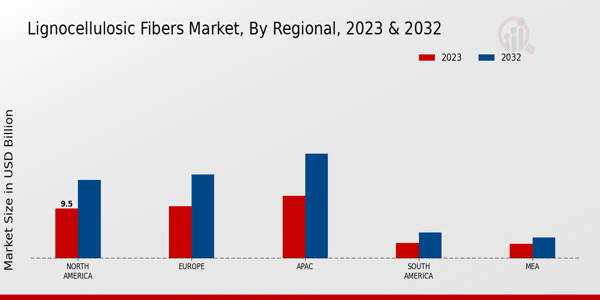Global Lignocellulosic Fibers Market Overview
The Lignocellulosic Fibers Market Size was estimated at 41.45 (USD Billion) in 2024. The Lignocellulosic Fibers Industry is expected to grow from 43.70 (USD Billion) in 2025 to 70.29 (USD Billion) by 2034. The Lignocellulosic Fibers Market CAGR (growth rate) is expected to be around 5.4% during the forecast period (2025 - 2034).
Key Lignocellulosic Fibers Market Trends Highlighted
The lignocellulosic fibers market expansion is positive as there are some notable market drivers. One of the factors that promote this trend is the growing popularity of biodegradable and organic materials in the textile, construction, and automotive industries, among others. These fibers come from plants as well as other natural sources and therefore are renewable which is in high demand over synthetic fibers and other materials. Furthermore, the improvement in regulations concerning non-biodegradable materials as well as improvement in consumer awareness about the environment encourage the utilization of these fibers. They are also light in weight with good mechanical properties thereby broadening the scope of their utilization and increasing their demand from the innovation and sustainable focused markets.The lignocellulosic fibers market is witnessing notable growth due to several key market drivers. The increasing demand for sustainable and eco-friendly materials in various industries, such as textiles, construction, and automotive, fuels this trend. Lignocellulosic fibers, derived from natural sources like plants, offer a renewable alternative to synthetic fibers and materials. Additionally, stringent regulations regarding the use of non-biodegradable substances and rising environmental awareness among consumers further drive the adoption of these fibers. Their lightweight nature and excellent mechanical properties make them suitable for a wide range of applications, enhancing their demand in sectors focused on innovation and sustainability.There are various opportunities to be explored in this market. The rising interest in biocomposites and bio-based products is fostering innovation in lignocellulosic fiber processing and applications. Manufacturers can invest in research and development to create value-added products tailored for specific industries. The emerging trend of circular economy practices presents another opportunity, as companies seek to utilize waste materials effectively. Integrating lignocellulosic fibers into new applications, such as packaging and insulation materials, could diversify their market presence and appeal to eco-conscious consumers. In recent times, the industry has seen trends toward digitalization and advanced manufacturing techniques that improve the efficiency of fiber production.Companies are adopting automation and smart manufacturing processes to enhance productivity and reduce costs. The trend of collaboration among stakeholders, including manufacturers, research institutions, and government bodies, is also gaining momentum, aiming to promote the benefits of lignocellulosic fibers. Furthermore, the expansion of e-commerce platforms is creating better access for customers seeking these sustainable fibers, supporting market growth. As awareness increases and technology advances, the landscape for lignocellulosic fibers continues to evolve, offering exciting prospects for the future.
Source: Primary Research, Secondary Research, MRFR Database and Analyst Review
Lignocellulosic Fibers Market Drivers
Rising Demand for Sustainable Materials
The Lignocellulosic Fibers Market Industry is experiencing significant growth due to the increasing demand for sustainable and eco-friendly materials across various sectors. Consumers are becoming more environmentally conscious, and as a result, there is a growing preference for products that minimize environmental impact. Lignocellulosic fibers, being derived from renewable biomass such as plants and agricultural waste, align perfectly with this consumer trend.Industries including textiles, packaging, automotive, and construction are actively seeking alternatives to conventional petroleum-based products, driving the adoption of lignocellulosic fibers. Furthermore, governments worldwide are implementing regulations and incentives to promote the use of sustainable materials, which is further enhancing the market for lignocellulosic fibers. As the awareness of health and environmental issues rises, manufacturers are increasingly shifting towards renewable and recyclable materials, thus escalating the demand for lignocellulosic fibers in the market.This transition towards sustainability is anticipated to play a crucial role in shaping the future of the Lignocellulosic Fibers Market Industry and its growth trajectory.
Technological Advancements in Fiber Processing
Innovations and advancements in fiber processing technologies are propelling the Lignocellulosic Fibers Market Industry forward. These technological improvements enhance the efficiency of extracting fibers from lignocellulosic materials, making them more accessible for various applications. Modern processing techniques enable higher yield rates and better quality of fibers, which are vital for catering to diverse industrial needs. As processing technologies evolve, manufacturers are capable of optimizing production, which in turn is reducing costs and increasing the affordability of lignocellulosic fibers.The rising adoption of automation and smart manufacturing practices in fiber processing also plays a significant role in improving product quality and minimizing environmental footprint, thus driving market growth.
Growing Awareness of Health and Wellness
The increasing awareness of health and wellness among consumers is contributing to the rapid expansion of the Lignocellulosic Fibers Market Industry. Lignocellulosic fibers are recognized for their potential benefits, particularly in the textile sector, where they are often perceived as healthier alternatives to synthetic fibers. This perception drives demand in not only clothing but also in various other applications such as home furnishings and industrial textiles.The promotion of natural materials, particularly in consumer goods, aligns well with the trend toward healthier lifestyles, thus spurring market growth.
Lignocellulosic Fibers Market Segment Insights
Lignocellulosic Fibers Market Application Insights
The Lignocellulosic Fibers Market is witnessing a robust growth trajectory, particularly notable within its Application segment, which includes Textiles, Construction, Automotive, and Packaging. The market is valued at 37.3 USD Billion in 2023, and it is expected to consistently expand, reflecting a heightened interest in sustainable materials. In 2023, the Textiles category holds a valuation of 10.5 USD Billion, making it a significant player within the Lignocellulosic Fibers Market, largely driven by the increasing eco-consciousness among consumers and the demand for natural fibers in clothing.Following closely is the Construction sector, valued at 9.0 USD Billion in 2023, where lignocellulosic fibers are increasingly utilized for insulation and composite materials, responding to the growing trend for sustainable building practices. The Automotive sector, with a valuation of 8.0 USD Billion, reflects a significant shift toward lightweight materials to enhance fuel efficiency and reduce emissions, positioning it as a major contributor to the market's overall growth. Lastly, the Packaging industry stands at 9.8 USD Billion in 2023, showcasing a demand surge for biodegradable alternatives to traditional plastics, echoing sustainability efforts.The collective impact of these applications contributes to the overall resilience and forward momentum in the Lignocellulosic Fibers Market, as each segment addresses pressing environmental and industrial concerns, ensuring their sustained relevance and growth potential in the coming years. The transition towards more sustainable practices across these applications underlines the industry's integral role in shaping a more environmentally friendly future.
Source: Primary Research, Secondary Research, MRFR Database and Analyst Review
Lignocellulosic Fibers Market Source Insights
The Lignocellulosic Fibers Market, with a revenue of 37.3 USD Billion in 2023, is poised for significant growth as it explores various Sources such as Wood, Bamboo, Hemp, and Agricultural Residues. Each of these sources plays a vital role in the market's dynamics, catering to the increasing demand for sustainable materials. Wood remains a traditional and dominant source, providing essential fibers for various applications due to its availability and utility. Bamboo is gaining traction, known for its rapid growth and renewability, thereby appealing to environmentally conscious consumers.Hemp, recognized for its versatile applications, is becoming increasingly popular due to its strong fibers and lesser environmental impact. Agricultural Residues also contribute significantly, transforming waste into valuable resources, thus promoting sustainability. The overall market shows promising trends as it adapts to evolving consumer preferences for natural and eco-friendly materials, driven by factors such as the growing awareness of sustainability and technological advancements. However, challenges such as sourcing consistency and supply chain management remain prevalent.Overall, the Lignocellulosic Fibers Market statistics reflect a diversified industry, with each Source segment showcasing unique growth drivers and opportunities for innovation and development.
Lignocellulosic Fibers Market Processing Technology Insights
The Lignocellulosic Fibers Market, valued at 37.3 USD Billion in 2023, is witnessing growth driven by advancements in Processing Technology. This technology segment plays a vital role in transforming lignocellulosic materials into valuable fibers and is projected to see increased investments and innovations. Within this segment, Mechanical Processing focuses on physical methods to extract fibers, contributing significantly to the efficiency and sustainability of production. Chemical Processing incorporates various chemicals to enhance fiber quality and yield, which is pivotal for applications in textiles and composites.Biological Processing leverages enzymes and microorganisms for more environmentally friendly extraction processes, appealing to a growing demand for sustainable practices in the industry. Together, these methods contribute to a substantial portion of the overall market revenue and are critical in addressing current challenges such as resource efficiency and environmental impact, highlighting significant opportunities for growth. The market statistics indicate a robust trajectory as companies seek to optimize these technologies, aligning with broader trends in sustainability and innovation in manufacturing.
Lignocellulosic Fibers Market End Use Insights
The Lignocellulosic Fibers Market is expected to showcase impressive growth, with a market value of 37.3 USD Billion in 2023 and reaching 60.0 USD Billion by 2032. This growth is supported by an expected compound annual growth rate (CAGR) of 5.42 from 2024 to 2032. Within the End Use segment, various applications play critical roles, such as composites, insulation materials, and pulp and paper. The composites sector, particularly popular in automotive and construction, often dominates due to the increasing demand for sustainable and lightweight materials.Insulation materials derived from lignocellulosic fibers are gaining traction as they offer excellent thermal performance while being biodegradable, thus supporting eco-friendly initiatives. The pulp and paper industry also utilizes lignocellulosic fibers for producing high-quality paper products, which continues to be significant in a world where sustainability is becoming a priority. The Lignocellulosic Fibers Market segmentation reflects a diverse application landscape and highlights the industry's potential in addressing environmental concerns while satisfying market demand.As businesses and consumers alike seek greener alternatives, opportunities for market growth will continue to flourish in these key areas.
Lignocellulosic Fibers Market Regional Insights
The Lignocellulosic Fibers Market revenue showcases a steady growth trajectory across various regions. In 2023, the North American market generated a value of 9.5 USD Billion, while Europe followed closely behind at 10.0 USD Billion. APAC leads the charge with 12.0 USD Billion, demonstrating significant demand and dominance due to its extensive agricultural resources. South America, valued at 3.0 USD Billion, and the MEA region at 2.8 USD Billion, show the least market uptake but still present essential opportunities for growth. The robust valuation in APAC is driven by the increasing focus on sustainable materials, making it a critical player in the Lignocellulosic Fibers Market segmentation.Europe’s strong regulatory support for eco-friendly products further solidifies its significant market position. North America, holding a major share, emphasizes innovation in lignocellulosic applications. Overall, these regions reflect diverse dynamics and growth potential, shaped by local industrial demands and sustainability trends, revealing vital insights through the Lignocellulosic Fibers Market data and statistics.
Source: Primary Research, Secondary Research, MRFR Database and Analyst Review
Lignocellulosic Fibers Market Key Players and Competitive Insights
The Lignocellulosic Fibers Market is characterized by a diverse landscape comprising various players, each making significant contributions to the sector. Lignocellulosic fibers, derived from plants, are increasingly recognized for their sustainability and versatility in numerous applications, including textiles, composites, and bioproducts. As the market shifts towards eco-friendly alternatives, companies that innovate in harnessing these fibers are gaining a competitive edge. The market dynamics involve varying degrees of technological advancements, geographical presence, and strategic collaborations, all of which shape the competitive atmosphere. Stakeholders are continuously exploring new strategies to enhance product offerings and tap into emerging markets, leading to a highly competitive environment where efficiency, sustainability, and product quality are paramount.Kraton stands out within the Lignocellulosic Fibers Market due to its robust commitment to sustainability and innovative product development. The company's strategic focus on high-quality lignocellulosic fibers provides a competitive advantage as it addresses increasing consumer demand for sustainable materials across various industries. Through extensive research and development, Kraton has been able to enhance the performance and applicability of its fibers, making them suitable for a wide range of applications. Its strong market presence is bolstered by established relationships with customers, which facilitates collaboration and feedback for continuous improvement. Additionally, Kraton's expertise in developing specialized products positions it favorably against competitors, enabling the company to maintain a leadership role in the evolving market landscape.Mondi also plays a vital role in the Lignocellulosic Fibers Market, offering a diverse range of products that align with market trends emphasizing sustainability and eco-friendliness. The company's commitment to innovation is evidenced in its development of high-performance lignocellulosic fibers that meet rigorous industry standards. With a comprehensive supply chain network and a strong footprint, Mondi effectively addresses varying customer needs and market demands, positioning itself as a reliable partner for businesses seeking sustainable fiber solutions. The integration of cutting-edge technology in its production processes enhances the quality and efficiency of Mondi's offerings. Furthermore, the company's dedication to sustainable practices not only resonates with environmentally conscious consumers but also strengthens its competitive standing in a burgeoning market that prioritizes green alternatives.
Key Companies in the Lignocellulosic Fibers Market Include
-
Kraton
-
Mondi
-
Huntsman
-
Solvay
-
Novozymes
-
Mitsui Chemicals
-
Trelleborg
-
Rayonier
-
Azelis
-
Komatsu Seiren
-
BASF
-
Sappi
-
Celanese
-
DuPont
-
Eastman
Lignocellulosic Fibers Market Industry Developments
Recent developments in the Lignocellulosic Fibers Market show a notable trend towards sustainability, with companies like Kraton and Mondi investing in eco-friendly production methods to meet increasing consumer demand for green products. Huntsman and Solvay are also on the forefront, focusing on bio-based materials that could redefine standard manufacturing processes. Additionally, Novozymes has made significant strides in enzyme technology that enhances the efficiency of lignocellulosic fiber utilization.Current affairs indicate heightened market consolidation, as several companies explore mergers and acquisitions to improve their competitive position. For example, Mitsui Chemicals has been involved in strategic discussions to acquire smaller firms specializing in bio-based materials, which could bolster its market portfolio. Trelleborg and Rayonier are exploring collaborations aimed at innovation in applications for lignocellulosic fibers, while Azelis is expanding its distribution network in response to growing market opportunities.Valuation growth is evident as BASF and Sappi report increased revenues tied to their lignocellulosic offerings, directly impacting market dynamics and encouraging further investment in research and development. Celanese and DuPont are also positioned to leverage this growth through enhanced product lines that cater to evolving industry needs.
Lignocellulosic Fibers Market Segmentation Insights
Lignocellulosic Fibers Market Application Outlook
-
Textiles
-
Construction
-
Automotive
-
Packaging
Lignocellulosic Fibers Market Source Outlook
-
Wood
-
Bamboo
-
Hemp
-
Agricultural Residues
Lignocellulosic Fibers Market Processing Technology Outlook
-
Mechanical Processing
-
Chemical Processing
-
Biological Processing
Lignocellulosic Fibers Market End Use Outlook
-
Composites
-
Insulation Materials
-
Pulp and Paper
Lignocellulosic Fibers Market Regional Outlook
-
North America
-
Europe
-
South America
-
Asia Pacific
-
Middle East and Africa
| Report Attribute/Metric |
Details |
| Market Size 2024 |
41.45 (USD Billion) |
| Market Size 2025 |
43.70 (USD Billion) |
| Market Size 2034 |
70.29 (USD Billion) |
| Compound Annual Growth Rate (CAGR) |
5.4% (2025 - 2034) |
| Report Coverage |
Revenue Forecast, Competitive Landscape, Growth Factors, and Trends |
| Base Year |
2024 |
| Market Forecast Period |
2025 - 2034 |
| Historical Data |
2020 - 2024 |
| Market Forecast Units |
USD Billion |
| Key Companies Profiled |
Kraton, Mondi, Huntsman, Solvay, Novozymes, Mitsui Chemicals, Trelleborg, Rayonier, Azelis, Komatsu Seiren, BASF, Sappi, Celanese, DuPont, Eastman |
| Segments Covered |
Application, Source, Processing Technology, End Use, Regional |
| Key Market Opportunities |
Sustainable packaging solutions development, Bio-composite materials innovation, Growing demand in textiles, Increased use in construction, Advancements in biofuel production |
| Key Market Dynamics |
Sustainable raw material demand, Innovation in production technologies, Growing end-user applications, Environmental regulations and policies, Increased bio-based product adoption |
| Countries Covered |
North America, Europe, APAC, South America, MEA |
Frequently Asked Questions (FAQ) :
The Lignocellulosic Fibers Market is expected to reach a valuation of 70.29 USD Billion by 2034.
The expected CAGR for the Lignocellulosic Fibers Market from 2025 to 2034 is 5.4%.
The Textiles application segment is projected to grow to 17.5 USD Billion by 2034.
The Construction application segment is expected to be valued at 14.5 USD Billion by 2034.
North America is projected to reach a market value of 15.0 USD Billion by 2034.
Major players include Kraton, Mondi, Huntsman, and BASF among others.
The Automotive application segment is expected to be valued at 12.5 USD Billion by 2034.
The Packaging application segment is anticipated to reach 15.5 USD Billion by 2034.
The APAC region is expected to grow to a market value of 20.0 USD Billion by 2034.
South America is projected to reach a market size of 5.0 USD Billion by 2034.

















